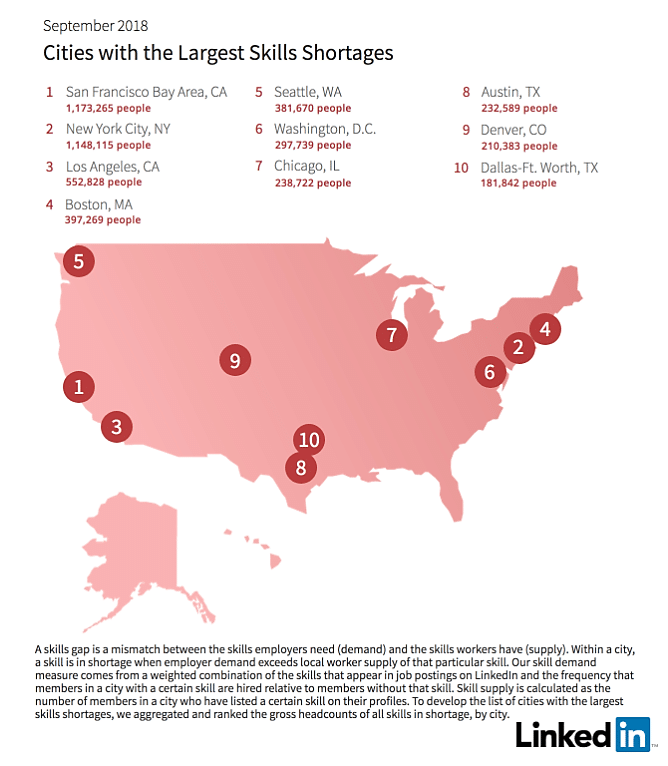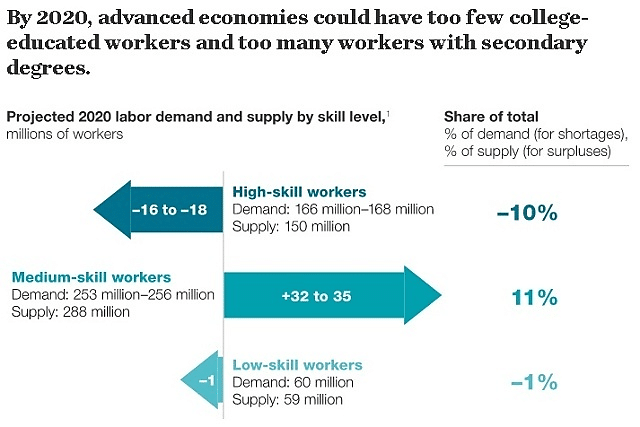The US broke many long-standing employment and labor records in 2018, with the effects rippling through all business verticals nationwide. With the 2008 recession now 10 years behind us, the 2018 economy showed strong jobs growth and shrinking unemployment. This is good news for job candidates who are looking to upgrade their jobs. For businesses, however, last decade’s hiring strategies won’t work anymore. The talent pool is shrinking, and updated strategies are a must.
In a talent shortage, candidates (not employers) have the power to dictate wages, benefits, and job content. Competition for qualified candidates is stiff, and potential employees have demand on their side. Just this year:
- Youth unemployment hit its lowest level since 1966.
- The number of open jobs exceeds unemployed persons by 659,000.
- The economy has created 2.5 million jobs, representing 66.7 million hires.
- The Bureau of Labor Statistics reported that April closed with 6.7 million job openings.
- Unemployment dropped to 3.8%, its lowest level since 1969.
Despite high demand, only 50% of employees feel like their wages are competitive with market rates.
Death by Automation
Despite the longest bull market run in history, candidates don’t always have it easy, either. A recent McKinsey report estimated that 50% of today’s jobs are susceptible to automation by artificial intelligence. This used to be a distant vision of the future, but today, many of these technologies are already available on the market. Half of the tasks employees do today can be automated, reducing the demand for some skills that most people use as leverage in qualifying for a position. Once While less than 5% of all occupations can be automated entirely using technology, about 60% of all occupations have at least 30% of activities that could be automated.

Skills Shortages
Not to mention the staggering skills shortages throughout the nation. If candidates want to remain marketable, they must learn some new skills. According to a LinkedIn survey, the hard skills companies need most are cloud and distributed computing, statistical analysis and data mining, middleware and integration software, web architecture and development framework, user interface design, software revision control systems, network and information security, and SEO/SEM marketing.
The trend is obvious here – companies are desperate for digital skills to keep up with the increasing amount of technology required in modern business. Software development skills, such as performance tuning and SQL are required for over 850,000 open roles right now. To put this in perspective, the talent pool only contains 472,000 professionals with those skills.
The need for highly specialized workers is at an all-time high, while the pool of educated and qualified candidates is strikingly low. Trends in education levels and projected employment needs indicate that employers will require about 18 million more college-educated workers than will be available in 2020, a gap representing 11% of demand. Complicating the situation is the student debt crisis, called a bubble by many leading economists. The burden of debt is unsustainable based on the earning potential of most college degrees, especially arts, languages, and other non-STEM areas of study.

Economists don’t expend a reversal of this trend any time soon. Underqualified talent cannot leverage skills that are universal or able to be automated, lowering performance. Low performance reduces revenue, and therefore capital. Without the capital to modernize, companies cannot compete – in their markets or for gaining candidates. This cycle feeds itself, reducing candidates and marketability, sometimes to the point of bankruptcy.
Talent Pool Predictions
What’s next? Employee development and training is a proven way to reduce turnover. Companies nationwide are investing more in educational programs and expanding the skill set of their internal teams. This can help in modernization and retention, fending off some of the competition poaching. The promise of personal and professional development can be a key factor in a potential candidate’s decision making.
If companies want to boost growth, they need the right employees. However, to get the right employees, hiring managers need updated recruiting strategies. They must focus less on what the employee can do for the company, and more on what the company can do for the employee. Today’s professionals are looking for not only financial rewards, but recognition and a future. Despite employer belief, the top reason individuals left their jobs was due to career progression – not salary. Out of the employers surveyed, 48% have a strategy in place to promote company culture to make their company more attractive, and 43% leverage competitive salary packages.
What makes your company a place that a qualified, highly-desired candidate wants to work (or in many cases, leave their current company for)? At Blue Signal Search, we call this a company’s “sizzle”. If you are experiencing some of the growing pains of this shrinking talent pool and the digital age, contact us today. We can help you find your true value proposition – your sizzle – and market it to find the right candidate for your open role.
Need help with your recruiting strategy? Contact us at (480) 939-3200 or reach out to info@bluesignal.com.

